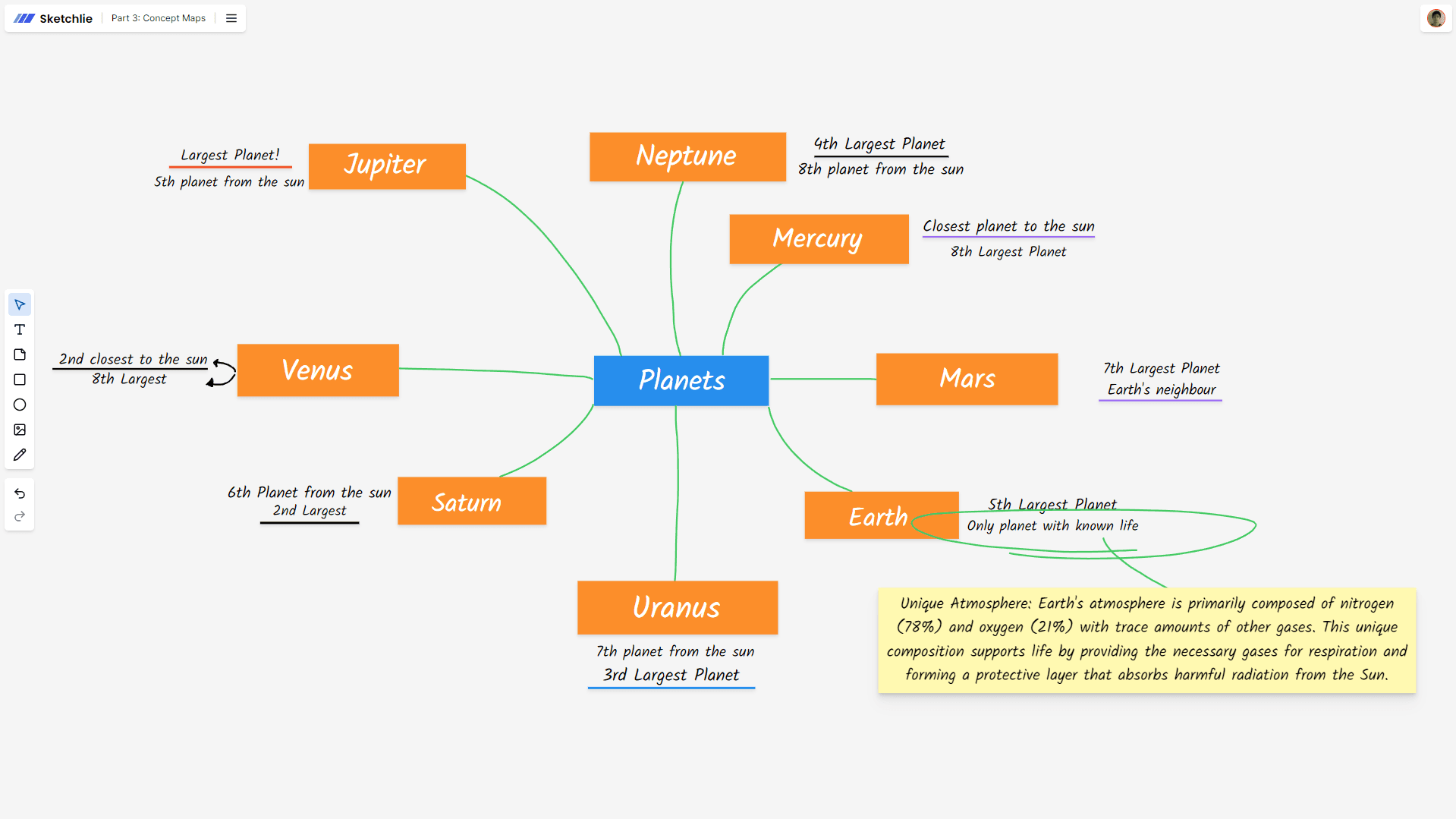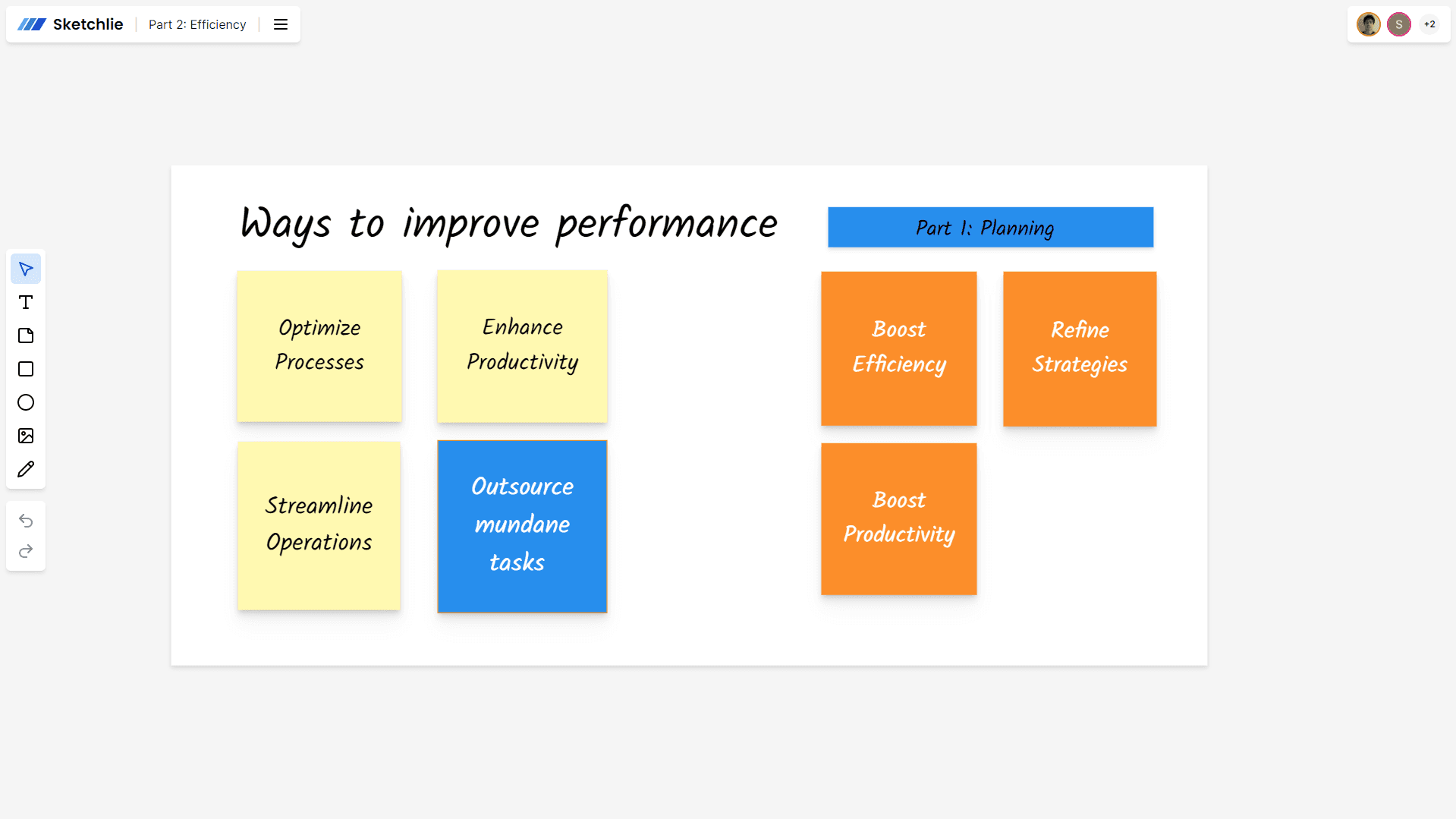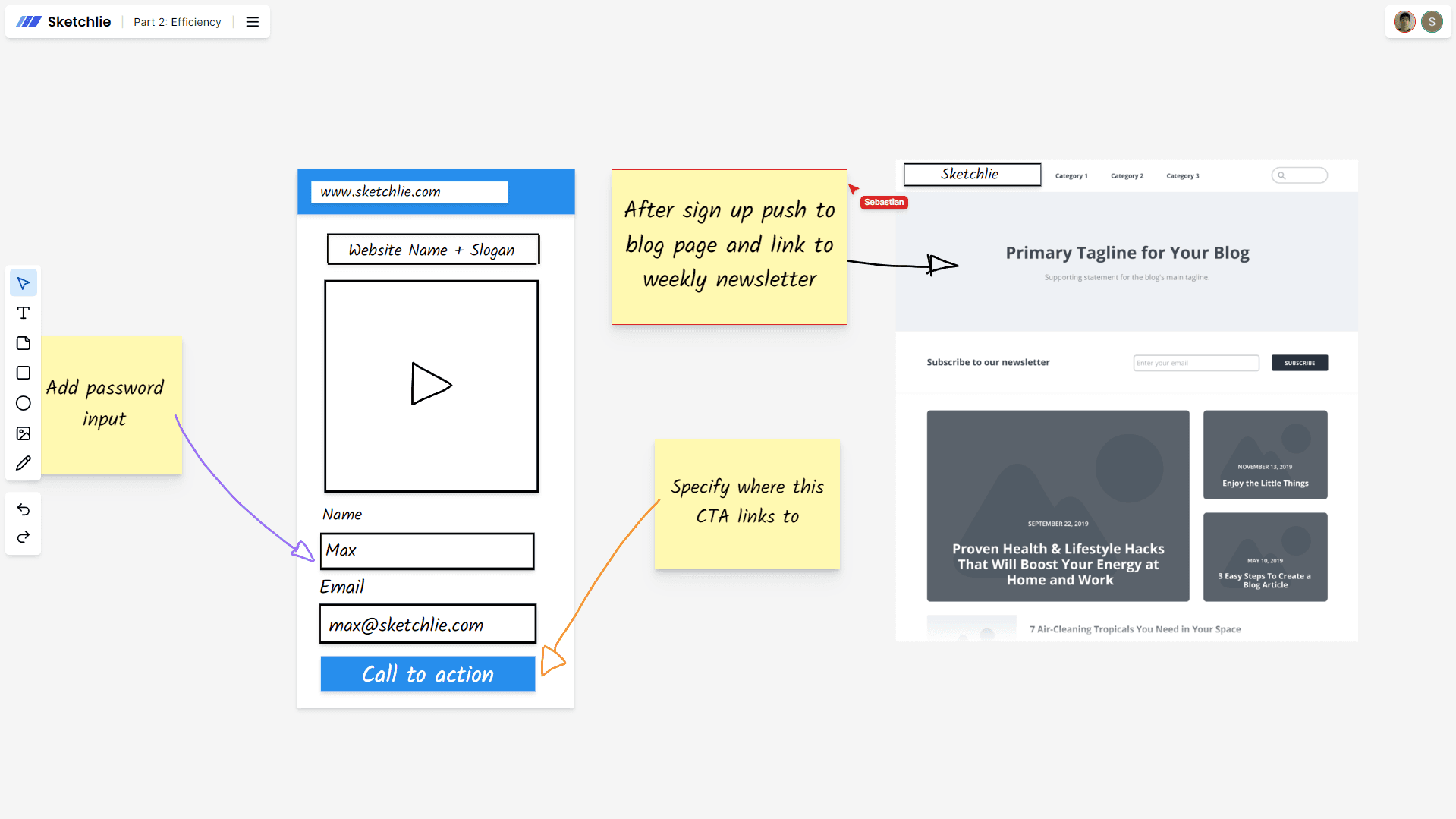- Home
- Concept Map
- What is a Concept Map?
Concept map

What is a Concept Map?
A concept map is a visual tool that allows you to organize and represent information in a hierarchical and structured manner. It is used to connect ideas and concepts, showing the relationships between them in a clear and concise way. These maps are useful for both learning and project planning, as well as problem-solving.At Sketchlie, we offer an online platform for real-time collaboration, where you can create concept maps easily and efficiently, facilitating communication and teamwork.Tools for Creating Online Concept Maps
Creating concept maps online is an excellent way to leverage technology for collaboration and idea organization. At Sketchlie, we offer a variety of tools and features to facilitate this process:- Intuitive Interface: Our platform features a user-friendly interface that allows users to create and edit concept maps quickly and efficiently.
- Real-Time Collaboration: With Sketchlie, multiple users can work simultaneously on the same concept map, facilitating collaboration and team idea generation.
- Wide Range of Tools: We offer a variety of drawing tools, image and object insertion, as well as text and labeling functions to customize and enrich your concept maps.
In addition to these tools, Sketchlie also provides export options and integration with other applications to maximize the versatility and compatibility of your projects.
Interested in learning more about other online collaboration tools? Discover how you can use online whiteboards, mind maps, and more in your daily work.What is the main objective of Concept Maps?
The main objective of concept maps is to organize and represent information in a visual and structured way, facilitating the understanding and analysis of complex concepts. These tools are especially useful in educational settings, where they help students organize their ideas, relate concepts, and improve their study and information retention abilities.
Furthermore, concept maps are widely used in the professional world for project planning, decision-making, and effective communication between work teams. By visualizing the relationships between different elements, concept maps allow for the identification of patterns, detection of areas for improvement, and generation of new ideas collaboratively.
How to Create a Concept Map
Creating an effective concept map requires following certain steps and techniques to organize information clearly and coherently. Here's a basic guide on how to do it:
- Identify the central theme: Define the main topic or concept you want to represent in your concept map.
- Select key ideas: Identify the main ideas or concepts related to the central theme and group them logically.
- Establish connections: Use lines or arrows to connect ideas and show the relationships between them.
- Add details: Complete your concept map by adding details, examples, or explanations that enrich the understanding of the topic.
- Review and edit: Review your concept map to ensure that the information is clear and well-organized, and make any necessary edits.
By following these steps, you can create effective concept maps that will help you organize your ideas and communicate them in a visual and structured manner.
For more tips on how to improve your organization and collaboration skills, check out our tips for brainstorming activities and other teamwork techniques.Types of Concept Map Techniques
There are several techniques and approaches to creating concept maps, each adapted to different needs and contexts. Some of the most common types of concept maps include:
- Hierarchical: Organizes information in a stepped manner, showing the subordination relationship between concepts.
- Radial: Places the central theme in the center of the map and organizes related concepts in concentric circles around it.
- Process Flow: Shows the steps or stages of a process in sequence, with arrows indicating the direction of flow.
Depending on the purpose and nature of your project, you can choose the concept map technique that best suits your needs. At Sketchlie, we offer versatile tools that allow you to create and customize different types of concept maps according to your specific preferences and requirements.
Main Uses of Concept Maps
Concept maps have a wide range of applications in various fields, from education to project management. Some of the main uses include:
- Learning and Teaching: In the educational field, concept maps are effective tools for organizing and understanding information, facilitating the learning process for both students and teachers.
- Planning and Management: In the business world, concept maps are used to plan projects, define objectives and strategies, and visualize complex processes in a clear and concise manner.
- Problem Solving: Concept maps are useful for identifying causal relationships, analyzing problems, and finding creative solutions, as they allow for a comprehensive visualization of all involved elements.
At Sketchlie, our online collaboration platform, you can make the most of concept maps to enhance creativity, productivity, and efficiency in your projects.
Tips for Creating Effective Concept Maps
To create effective concept maps, it's important to follow some guidelines and best practices. Here are some useful tips:
- Simplify: Keep your concept maps simple and clear, using keywords and main concepts to represent information concisely.
- Organize Hierarchically: Structure your concept map hierarchically, placing the most general concepts at the top and specific details in lower levels.
- Use Meaningful Connections: Connect related concepts with lines or arrows and label each connection with a word or phrase that describes the relationship between them.
- Use Colors and Shapes: Utilize different colors and shapes to categorize and highlight important concepts or relationships.
- Revise and Refine: Continuously review and refine your concept map as you gain new insights or information.
By following these tips, you can create more effective and visually appealing concept maps that enhance understanding and communication of complex ideas.
Examples of Concept Maps
Here are three examples of concept maps that illustrate different applications and styles:
- Example 1: A concept map about the water cycle, showing the different stages and processes involved in the hydrological cycle.
- Example 2: A concept map about the theory of evolution, representing the relationships between species, common ancestors, and mechanisms of natural selection.
- Example 3: A concept map about time management, showing strategies and techniques for optimizing productivity and personal performance.
These examples demonstrate the versatility and usefulness of concept maps in different contexts and areas of knowledge.
Organizing Concept Map Workshops
If you're interested in organizing a workshop or work session on concept maps, here are some tips to ensure its success:
- Define Objectives: Before starting the workshop, establish clear objectives and expectations so that participants know what to expect and what is expected of them.
- Provide Clear Instructions: Explain the techniques and tools needed to create concept maps, and offer examples and demonstrations to guide participants.
- Encourage Participation: Encourage participants to share their ideas and actively contribute to the creation of concept maps, promoting collaboration and knowledge exchange.
By following these tips, you can organize concept map workshops that are educational, interactive, and productive for all involved.
Tips for Your Concept Map Activities
To get the most out of your concept map activities, consider the following tips:
- Explore Different Styles and Formats: Experiment with different styles and formats of concept maps to find the one that best suits your needs and preferences.
- Use Colors and Visual Elements: Incorporate colors, icons, and other visual elements to highlight key concepts and improve the readability of your concept map.
- Review and Update Regularly: Review and update your concept maps periodically to reflect changes in your knowledge or in the situation you're addressing.
By following these tips, you can make the most of your concept map activities, increasing your ability to organize, understand, and communicate information effectively.
In summary, concept maps are powerful tools for organizing and visually representing ideas and concepts. At Sketchlie, we offer an online platform for creating concept maps collaboratively, facilitating communication and teamwork. Join our community and discover all you can achieve with online concept maps!Ready to get started? Sign up now on Sketchlie and start creating your own concept maps quickly and easily. Boost your creativity and productivity with our online collaboration tools!
Indice
- What is a Concept Map?
- Tools for Creating Online Concept Maps
- What is the main objective of Concept Maps?
- How to Create a Concept Map
- Types of Concept Map Techniques
- Main Uses of Concept Maps
- Tips for Creating Effective Concept Maps
- Examples of Concept Maps
- Organizing Concept Map Workshops
- Tips for Your Concept Map Activities

